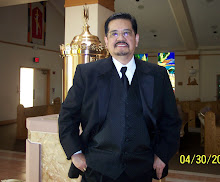The barrio used to be called Papaya until 1957, is now known as General Tinio. A first class municipality, it boasts of a population of 42,634 people.
The town is at the foot of the Sierra Madre Mountain, adjoining the Fort Magsaysay Army Reservation on the east side.
Nipa comes from the palm family of plants, and because it is the major component of the house, the house built out of it had been called a Nipa Hut. It is a type of stilt house indigenous to most of the lowland cultures of the Philippines.
But these houses soon disappeared as families in our barrio slowly upgraded into modern structures built of cement and steel. Then the boom years quickly happened as residents found work overseas, and today, the houses leading up to the main church are big, grandiose and affluent.
What about the church?
The church which was located in the Town Plaza and where we attended mass during Christmas and town fiestas has become the second church. It is called Sto. Cristo.
 |
| Sto. Cristo Church, where burial masses are now held |
 In the mid-90's, the Holy Cross Church was built, farther from the center of politics (the Municipal Hall) and still farther from the nexus of trade (the local wet market). The new church is fondly called "simbahang bago," (new church) by the locals.
In the mid-90's, the Holy Cross Church was built, farther from the center of politics (the Municipal Hall) and still farther from the nexus of trade (the local wet market). The new church is fondly called "simbahang bago," (new church) by the locals. | Holy Cross Church, bigger and newer church in General Tinio, Nueva Ecija |
 |
| Interior of the Holy Cross Church |
| The Sto. Cristo Church and the Holy Cross Church are under the Roman Catholic Diocese of Cabanatuan. | |||||||||||||||||||||||||||||||||||||||||||||||||||||||||||||||||||||||||||||||||||||||||||||||||||||||||||||||||||||||||||||











